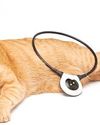
Teething. Whether a mother to human children or “mommy” to your fur children, teething is not a pleasant time in any household. Because of the age involved in teething, little ones cannot tell a parent or caregiver where it hurts, but the evidence of little teeth buds in a baby’s mouth is a dead giveaway. And, believe it or not, kittens are much the same, right down to not being able to tell us where it hurts.
Kitten Teething Stages
Kittens are born without teeth, and their set of 26 baby teeth “begin erupting around three weeks of age, and are usually fully in between six and eight weeks of age.”1
The second teething stage begins between three and four months of age and lasts two to three months. The first teeth are the incisors, or front teeth, which are followed by the canine teeth. The last permanent teeth to erupt are the premolars and molars.1 A normal feline will have 30 permanent adult teeth.
Signs of Teething1
1. Kittens may be reluctant to eat; chew differently, prefer soft foods. Drooling can also occur if teeth are missing or recently lost.
2. Excessive chewing may occur. Fortunately, kittens are not as aggressive as puppies, but chewing eases the pressure from erupting teeth.1
3. Kittens may shake their heads or paw at their muzzles, a very clear indication of where the discomfort is.
4. Because there is mild discomfort, some kittens may become grumpy and may not want their faces touched. Grooming them may mean additional irritation for those already sensitive gums.
How Can We Help a Teething Kitten?
This story is from the February 2024 edition of Cat Talk.
Start your 7-day Magzter GOLD free trial to access thousands of curated premium stories, and 9,000+ magazines and newspapers.
Already a subscriber ? Sign In
This story is from the February 2024 edition of Cat Talk.
Start your 7-day Magzter GOLD free trial to access thousands of curated premium stories, and 9,000+ magazines and newspapers.
Already a subscriber? Sign In

Life With Patrick
Patrick and Mount Doom

Feline Photographers Part 1
\"Cats never strike a pose that isn't photogenic.\" - Lillian Jackson Braun

The Cat Fancy Alphabet
\"The Cat Fancy Alphabet\" is a new feature in Cat Talk. It highlights various terms and aspects of the cat fancy, educating fanciers new and old about our hobby.

UP CLOSE AND Purr-sonal
If there is one person, or even just a name, that anyone in CFA (Cat Fancier Association) knows, it would have to be Allene Tartaglia. It might be from her involvement with most aspects of the operations of CFA in her position of executive director. Or perhaps from her deep involvement with both the CFA Annual meeting and/or the International Show. Cat Talk thought it was time to learn more about one of the most key people in CFA.

Vision and Hearing Dysfunctions in Senior Cats
Just as people are challenged by having deficiencies with vision and hearing over time, so are senior cats. In senior cats, pet owners may notice their cats are no longer responding to them in the same way; however, it may be difficult to figure out.

Senior Cats and House Soiling
Why is my cat no longer using its litter box? Cat soiling in the house is one of the most talked about issues for pet owners.

Nutrition for Our Senior Cats
From the time they are born, our kittens receive a tremendous amount of care, with diet being at the core of their growth and development.

Fluffy's Sixteen and STILL Plays Like a Kitten!
Enrichment for Senior Cats

Alternative Arthritis Treatments for Cats
Just like humans, cats can experience arthritis. About 90% of cats over the age of 10 years experience osteoarthritis (OA) in at least one joint.1 It is a complex condition involving inflammation and degeneration of one or more joints and is sometimes referred to as degenerative joint disease (DJD). Cats with OA experience pain and inflammation in various joints that interfere with daily activities.

Checklist For What to Look For in Your Club's Next Show Venue
Show Manager To Ring One, Please